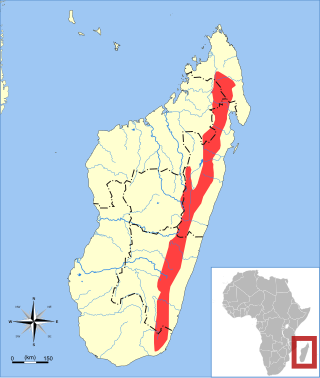
Bullimus is an endemic genus of rodent from the Philippines, as first catalogued by Mearns, in 1905.
Sooretamys angouya, also known as the rat-headed rice rat, and Paraguayan rice rat, is a rodent species from South America. It is found in northeastern Argentina, southern Brazil and Paraguay in forested areas within the Atlantic Forest and cerrado. Since 2006, it has been classified as the only species in the genus Sooretamys; previously, it was included in the genus Oryzomys. Its taxonomic history has been complex, with the names Oryzomys angouya, Oryzomys buccinatus, and Oryzomys ratticeps in use for various parts of the species at different times. Some variation in its karyotype has been reported, with 2n = 80 to 82 and FN = 88 to 90.

Waterhouse's swamp rat is a semiaquatic rodent species from South America. It is found in southern Brazil, Uruguay and northern Argentina, where it lives in freshwater and salt marshes, as well as open grassland of the pampas. Its karyotype has 2n = 24, substantially lower than its closest relative S. aquaticus with 2n = 32.

The Mindanao hairy-tailed rat is one of five species of rodent in the genus Batomys. It is in the diverse family Muridae. This species is found only in the Philippines.

The small white-toothed rat is a species of rodent in the family Muridae. It is found in Cambodia, Laos, Myanmar, Thailand, and Vietnam.

The Large Luzon Forest Rat, or Luzon Forest Rat is a species of rodent, the first of three to be described in the genus Bullimus. It is in the diverse family Muridae. It is found only in the Philippines. The rat has been recorded in Aurora, Benguet, and Camarines Sur provinces, and in Balbalasang, Kalinga province.

Geoxus valdivianus, also known as the long-clawed mole mouse or Valdivian long-clawed akodont, is a species of rodent in the tribe Abrotrichini of family Cricetidae found in the Valdivian temperate rain forests and Magellanic subpolar forests of Argentina and Chile. It is one of two species in the genus Geoxus.

The voalavoanala is a species of rodent in the family Nesomyidae. It is the only species in the genus Gymnuromys. It is found only in Madagascar. Its natural habitat is tropical dry forests.
The African smoky mouse or smokey heimyscus is a species of rodent in the family Muridae. It is the only species in the genus Heimyscus.
The red-bellied mosaic-tailed rat is a species of rodent in the family Muridae. It is the only species in the genus Protochromys. It is found only in Papua New Guinea.
Nectomys palmipes, also known as the Trinidad nectomys or Trinidad water rat, is a species of semiaquatic rodent in genus Nectomys of family Cricetidae. It is found on the island of Trinidad and on the nearby mainland of Venezuela.
Oligoryzomys arenalis, also known as the sandy colilargo or sandy pygmy rice rat, is a species of rodent in the genus Oligoryzomys of family Cricetidae. It is found in the Andes of Peru at 400 to 2850 m altitude, but may include more than one species.

Oligoryzomys vegetus, also known as the sprightly colilargo or sprightly pygmy rice rat, is a species of rodent in the genus Oligoryzomys of family Cricetidae. It is found only in the mountains of Costa Rica and western Panama.
Handleyomys melanotis, also known as the black-eared oryzomys or black-eared rice rat, is a species of rodent in the genus Handleyomys of family Cricetidae. It is found in coastal lowland forest in western Mexico.
The opossum rat is a species of rodent in the family Muridae. It is found only in northern and central Sulawesi, Indonesia.

Nectomys apicalis, also known as the western Amazonian nectomys, is a semiaquatic species of rodent in the genus Nectomys of family Cricetidae. It is found east of the Andes in Ecuador, Peru, and Bolivia, east into western Brazil; further to the east, it is replaced by N. rattus. It lives near watercourses in lowland tropical rainforest. Its karyotype has 2n = 38–42, and it probably actually represents several distinct undescribed species.
Oecomys catherinae, also known as the Atlantic Forest oecomys, is a species of rodent in the genus Oecomys from eastern Brazil.
Oligoryzomys brendae, also known as Brenda's colilargo, is a South American species of rodent in the genus Oligoryzomys. It is found only in Tucumán Province in northwestern Argentina, but its taxonomic status requires revision.
Geoxus annectens, also known as Pearson's long-clawed akodont or Pearson's long-clawed mouse, is a species of rodent in the tribe Abrotrichini of family Cricetidae. Molecular data suggests that its closest relative is Geoxus valdivianus. Formerly classified in its own genus, Pearsonomys, named after American zoologist Oliver Payne Pearson, it was moved to Geoxus in 2016 after a morphological and genetic reevaluation of the tribe Abrotrichini. This rodent is endemic to Chile, where it is found in Nothofagus forest of the Valdivian temperate rainforest ecoregion.
The fecund vesper mouse is a species of rodent in the family Cricetidae. It is known only from Bolivia, where it is found in the yungas and Tucumano boliviano forest ecoregions at elevations from 600 to 2700 m. It is regarded by some authorities as conspecific with C. boliviae, and by some as conspecific with C. venustus, despite having a karyotype with 2n = 54 while C. venustus generally has a karyotype with 2n = 56.











